|
|
|
|
|
FoAR 基于平格型地图对中国城市现存历史街区的空间尺度效应解析——以泉州古城东西街区为例 |
|
|
论文标题:Spatial scaling effects analysis of existing historical streets in Chinese cities based on the Ping Ge type map—In case study of Quanzhou East–West Street
期刊:Frontiers of Architectural Research
作者:Xinyi Chen, Yuhang Kong, Zhe Guo, Jianxun Zhang
发表时间:April 2025
DOI: https://doi.org/10.1016/j.foar.2024.08.007
微信链接:点击此处阅读微信文章
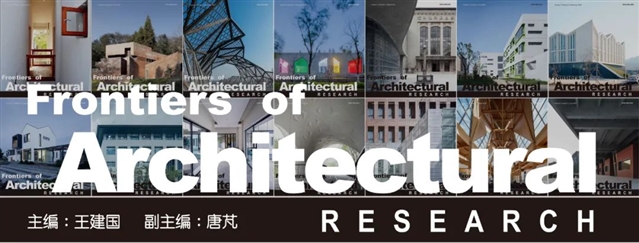
FoAR是由高等教育出版社和东南大学建筑学院联合主办的全英文学术期刊
建筑学 / 城乡规划 / 风景园林
本刊已被 A&HCI / CSCD / Scopus / DOAJ / CSTPCD 收录
中国科技期刊卓越行动计划 英文领军期刊
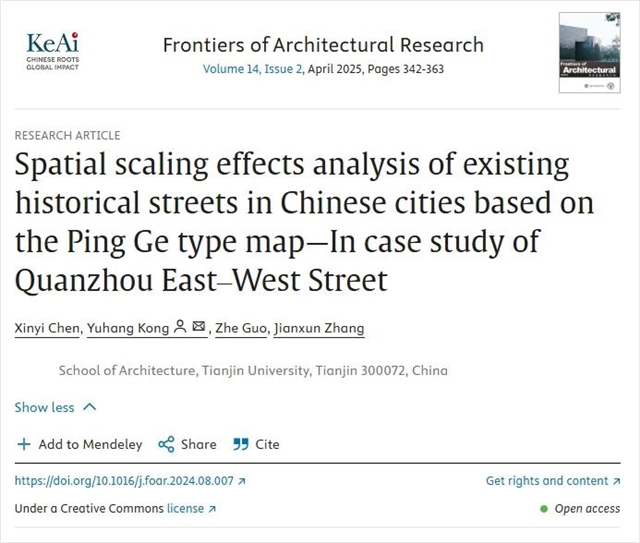
01 论 文 题 目
Manuscript Title
Spatial scaling effects analysis of existing historical streets in Chinese cities based on the Ping Ge type mapdIn case study of Quanzhou East–West Street
基于平格型地图对中国城市现存历史街区的空间尺度效应解析——以泉州古城东西街区为例
02 作 者
Authors
Xinyi Chen, Yuhang Kong* , Zhe Guo, Jianxun Zhang
School of Architecture, Tianjin University, Tianjin 300072, China
03 论 文 摘 要
Abstract
In response to the lack of objective evaluation criteria for interpreting the spatial scales of historical streets, as well as the problem of fragmented and complex textures, this research proposes an analysis method for assessing the spatial scaling effects using the Ping Ge type map. Drawing on the Ping Ge cartographic methods from the Qing Dynasty (1644-1911), it connects ancient measurement systems with objective evaluation criteria based on object relations and utilizes surveying maps from the Republic of China (1912-1949) to clarify temporal attributes of texture. The study employs a typical case study to demonstrate the feasibility of using the Ping Ge type map in interpreting historical streets. By creating the Ping Ge type map of the East?West Street in Quanzhou Ancient City and utilizing form diagrams, it reveals patterns such as scale multiplications within respective plots, transformations in linear sequences of streets, and increases or decreases in plot series scales. The case analysis indicates that the Ping Ge type map effectively uncover the spatial scaling characteristics of historical street layouts in China and can transform them into design resources that preserve the inner order of cities, thereby promoting spatial scaling awareness in the planning and design of regional architectural clusters.
针对在解读历史街区空间尺度时缺乏客观评价标准,以及街区肌理碎片化且复杂的问题,本研究提出了一种利用平格型地图来评估空间尺度效应的分析方法。借鉴清朝(1644-1911年)的平格制图方法,将古代度量衡系统与尺度评述相关联作为客观评价标准,并利用民国时期(1912-1949年)的测绘地图来厘清场地肌理的时间属性。研究采用了典型案例分析方法论证平格型地图在解读历史街区的可行性。通过绘制泉州古城东西街区的平格型地图,并运用形式图解,揭示了其公共建筑组群与民居组群所属地块的尺度倍数、街区线性序列的尺度缩放与地块组团面状层次的尺度增减规律。案例分析表明,平格型地图能够有效地揭示中国历史街区布局的空间尺度特征,并且可以将这些特征转化为维护城市内在秩序的设计资源,从而提升地域性建筑组群规划与设计中的空间尺度意识。
04 关 键 词
Keywords
Ping Ge type map / 平格型地图
Historical street / 历史街区
Spatial scaling effect / 空间尺度效应
Mapping method / 制图方法
Quanzhou East?West Street / 泉州古城东西街区
05 章 节 标 题
Sections Title
1. Introduction / 引言
2. Literature review / 文献综述
2.1. Spatial scaling identification method of historic streets in China / 中国历史街区空间尺度识别方法
2.2. Framework analysis of spatial scaling classification in historical streets / 历史街区空间尺度分类的框架分析
2.3. Ancient metrology system / 古代度量衡系统
3. Methodology / 研究方法
3.1. Background: the Ping Ge cartographic method of the Qing dynasty / 研究背景:清朝平格制图方法
3.2. Information and cartographic principles / 信息和制图准则
3.2.1. The basic unit in the Ping Ge type map / 平格网格的基本尺寸
3.2.2. Survey map of the Republic of China / 民国时期的测绘地图
3.3. Case selection / 案例择取
3.3.1. Quanzhou East?West Street / 泉州古城的东西街区
3.3.2. Comparison of 1922, 1937, and 1939s survey maps / 1922年、1937年与1939年测绘地图比较
4. Spatial scaling hierarchy analysis of the East?West Street / 泉州古城东西街区的空间尺度层级分析
4.1. Drawing a Ping Ge type map / 平格型地图绘制
4.2. Street scale interpretation / 街区尺度解读
4.3. Plot scale interpretation / 地块尺度解读
5. Spatial scaling effect analysis of the East?West Street / 泉州古城东西街的空间尺度效应分析
5.1. Linear scaling effects of the street / 街区的线性尺度效应
5.2. Planar scaling effects of plot series / 地块组团的面状尺度效应
6. Result and discussion / 结果与讨论
6.1. Spatial scaling effects of the Quanzhou East?West Street / 泉州古城东西街的空间尺度效应
6.2. Analytical method of the Ping Ge type map / 平格型地图的分析方法
7. Conclusion / 结论
06 主 要 插 图
Illustrations
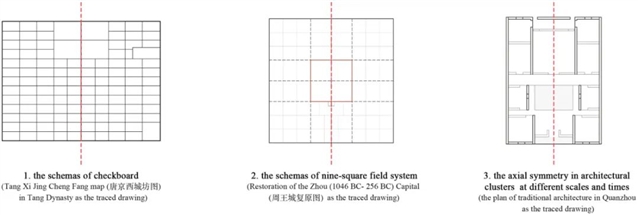
▲ 图一:历史街区中棋盘格,井田制,轴对称的空间布局图式。©本文作者
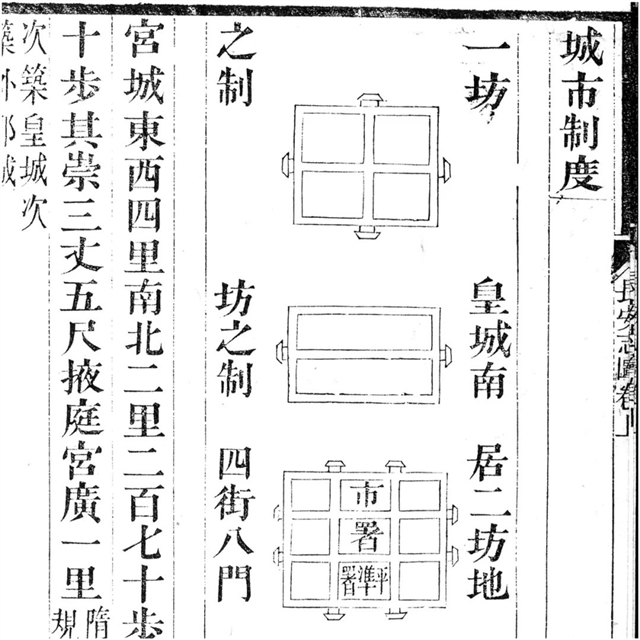
▲ 图二:“坊”的结构关系图示。资料来源:[宋]宋敏求,《长安志》,中华书局,北京,1991年。

▲ 图三:泉州古城东西街区的研究范围(白色虚线围合部分)。©本文作者
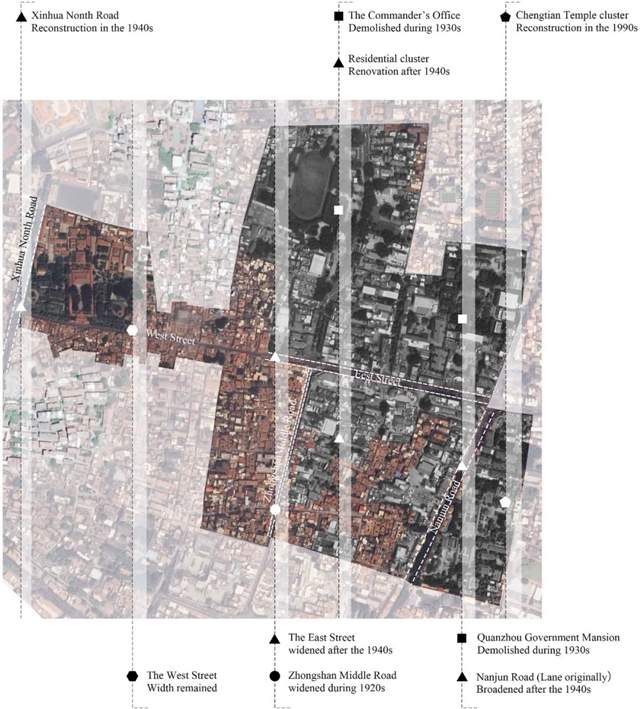
▲ 图四:泉州东西街区研究范围内建筑组群的拆除、扩建以及重建情况。©本文作者

▲ 图五:泉州东西街区平格型地图的分析方法构架示意。©本文作者
07 作 者 介 绍
Authors’ Information

陈心怡
博士研究生
天津大学建筑学院,天津,中国
研究方向:建筑设计及其理论;传统营建智慧挖掘与当代转译

孔宇航*
讲席教授、博士生导师
天津大学建筑学院,天津,中国
研究方向:建筑设计及其理论;非线性有机建筑;传统营建体系的当代转译

郭 喆
讲师
合肥工业大学建筑与艺术学院,安徽,中国
研究方向:基于交互的数字化复杂形态;生成式设计方法与技术;数字建筑遗产

张建勋
讲师
青海大学土木水利学院,青海,中国
研究方向:传统村落的保护与更新;低碳智慧城市规划与设计
08 原 文 阅 读
Download Link
阅读原文请点击“Spatial scaling effects analysis of existing historical streets in Chinese cities based on the Ping Ge type map—In case study of Quanzhou East–West Street”
▼ 点击下方词条 | 往期精彩不容错过
#期刊快讯#系列
1/ 主编王建国院士团队荣获国家科技进步奖一等奖
2/ JCR最新|FoAR 2023年度影响因子3.1,两项评价指标均位列WoS核心合集建筑类第一
3/ 最新|FoAR 2023 CiteScore 指数上升为6.2
4/ 最新|FoAR 被中国科技论文与引文数据库(CSTPCD)收录
5/ 最新|FoAR 再次入选中国国际影响力优秀学术期刊
6/ 最新|FoAR 荣获科爱十大优秀期刊奖
7/ 最新|FoAR进入2023年中国科学院分区表一区
8/ 最新|FoAR 入选"中国科技期刊卓越行动计划"英文领军期刊
9/ 最新|FoAR 2025中国科学院分区表大类小类保持一区
10/ 最新|FoAR 进入 EI 工程索引数据库
#年度报告#系列
1/ FoAR|2021年度报告
2/ FoAR|2022年度报告
3/ FoAR|2023年度报告
4/ FoAR|2024年度报告
#新刊上线#系列
2025年第一期
2025年第二期
#FoAR投稿指南#系列
1/ 投稿流程
2/ Guide for Author中文版
3/ 审稿流程及发表流程
4/ 如何提交修改稿
5/ 录用文章出版流程
#期刊知识科普#系列
1/ SCI之父尤金·加菲尔德的传奇人生
2/ 国际核心期刊数据库大解析
3/ 手把手教你如何使用最强工具Web of Science
4/ 如何发现一本好期刊
5/ 国内核心期刊有哪些
6/ 版面费与期刊影响力
#精彩文章#系列精选
01/ 城市设计实践发展的多元维度——基于UAL的案例研究
02/ 从智慧城市到共情城市
03/ 传统阿拉伯伊斯兰城市居住区形态学:以传统城市大马士革为例
04/ 建筑遗产预防性保护的意大利视角
05/ 生物与建筑:将科学知识与设计实践相结合的六家法国建筑事务所项目案例研究
06/ 颇具争议的渐进式改造:Elemental建筑事务所金塔蒙罗伊公屋居住区项目的15年
07/ 联合眼动实验和SD法的传统商业街区视觉效果感知评价
08/ 历史的层次:古城堡遗迹中的新建筑改造
09/ 通过空间句法检验帕拉第奥别墅平面中的控制性、中心性和灵活性
10/ 自1931年柯布西耶的Salubra色卡问世后其建筑色彩的偏好:一种跨文化的分析
11/ 建筑师身份的描绘:1920年代末的中国美术建筑师——刘既漂
12/ 探索暴露于风影响下织物的表达与功能
13/ 绿色屋顶能否在地中海气候条件下显著节约能源?基于不同案例的批判性评估
14/ 芬兰近期落成的原木建筑的建构及建筑品质:相关建筑师的解读
15/ 新加坡高校教室光环境品质研究
《前沿》系列英文学术期刊
由教育部主管、高等教育出版社主办的《前沿》(Frontiers)系列英文学术期刊,于2006年正式创刊,以网络版和印刷版向全球发行。系列期刊包括基础科学、生命科学、工程技术和人文社会科学四个主题,是我国覆盖学科最广泛的英文学术期刊群,其中12种被SCI收录,其他也被A&HCI、Ei、MEDLINE或相应学科国际权威检索系统收录,具有一定的国际学术影响力。系列期刊采用在线优先出版方式,保证文章以最快速度发表。
中国学术前沿期刊网
http://journal.hep.com.cn
特别声明:本文转载仅仅是出于传播信息的需要,并不意味着代表本网站观点或证实其内容的真实性;如其他媒体、网站或个人从本网站转载使用,须保留本网站注明的“来源”,并自负版权等法律责任;作者如果不希望被转载或者联系转载稿费等事宜,请与我们接洽。